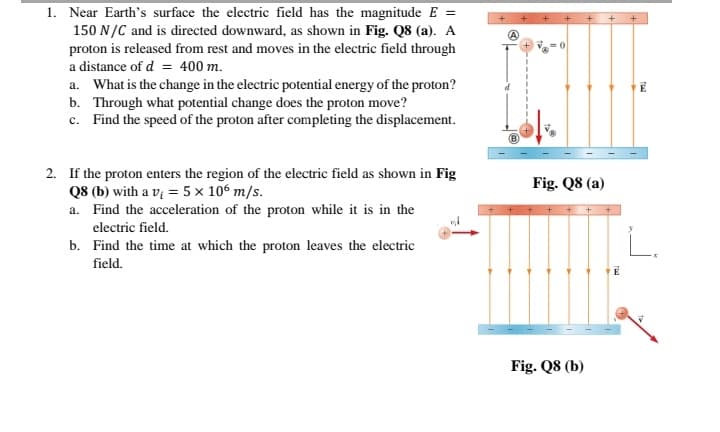1. Near Earth's surface the electric field has the magnitude E = 150 N/C and is directed downward, as shown in Fig. Q8 (a). A proton is released from rest and moves in the electric field through A a distance of d = 400 m. a. What is the change in the electric potential energy of the proton? b. Through what potential change does the proton move? c. Find the speed of the proton after completing the displacement. - - - - -
1. Near Earth's surface the electric field has the magnitude E = 150 N/C and is directed downward, as shown in Fig. Q8 (a). A proton is released from rest and moves in the electric field through A a distance of d = 400 m. a. What is the change in the electric potential energy of the proton? b. Through what potential change does the proton move? c. Find the speed of the proton after completing the displacement. - - - - -
Physics for Scientists and Engineers, Technology Update (No access codes included)
9th Edition
ISBN:9781305116399
Author:Raymond A. Serway, John W. Jewett
Publisher:Raymond A. Serway, John W. Jewett
Chapter25: Electric Potential
Section: Chapter Questions
Problem 25.54AP: Review. In fair weather, the electric field in the air at a particular location immediately above...
Related questions
Question
100%

Transcribed Image Text:1. Near Earth's surface the electric field has the magnitude E =
150 N/C and is directed downward, as shown in Fig. Q8 (a). A
proton is released from rest and moves in the electric field through
a distance of d = 400 m.
a. What is the change in the electric potential energy of the proton?
b. Through what potential change does the proton move?
c. Find the speed of the proton after completing the displacement.
2. If the proton enters the region of the electric field as shown in Fig
Q8 (b) with a vị = 5 x 106 m/s.
a. Find the acceleration of the proton while it is in the
electric field.
b. Find the time at which the proton leaves the electric
Fig. Q8 (a)
field.
Fig. Q8 (b)
Expert Solution
This question has been solved!
Explore an expertly crafted, step-by-step solution for a thorough understanding of key concepts.
Step by step
Solved in 2 steps with 1 images

Knowledge Booster
Learn more about
Need a deep-dive on the concept behind this application? Look no further. Learn more about this topic, physics and related others by exploring similar questions and additional content below.Recommended textbooks for you

Physics for Scientists and Engineers, Technology …
Physics
ISBN:
9781305116399
Author:
Raymond A. Serway, John W. Jewett
Publisher:
Cengage Learning

Physics for Scientists and Engineers: Foundations…
Physics
ISBN:
9781133939146
Author:
Katz, Debora M.
Publisher:
Cengage Learning

College Physics
Physics
ISBN:
9781938168000
Author:
Paul Peter Urone, Roger Hinrichs
Publisher:
OpenStax College

Physics for Scientists and Engineers, Technology …
Physics
ISBN:
9781305116399
Author:
Raymond A. Serway, John W. Jewett
Publisher:
Cengage Learning

Physics for Scientists and Engineers: Foundations…
Physics
ISBN:
9781133939146
Author:
Katz, Debora M.
Publisher:
Cengage Learning

College Physics
Physics
ISBN:
9781938168000
Author:
Paul Peter Urone, Roger Hinrichs
Publisher:
OpenStax College


Principles of Physics: A Calculus-Based Text
Physics
ISBN:
9781133104261
Author:
Raymond A. Serway, John W. Jewett
Publisher:
Cengage Learning

College Physics
Physics
ISBN:
9781305952300
Author:
Raymond A. Serway, Chris Vuille
Publisher:
Cengage Learning